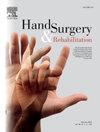肱三头肌分支长头转移至腋窝神经前段治疗三角肌复生:前路还是后路?解剖研究。
IF 1
4区 医学
Q4 ORTHOPEDICS
引用次数: 0
摘要
将肱三头肌长神经转移到腋窝神经是一种广泛应用的技术,用于恢复成人部分臂丛病变的肩外展和上凸。该手术可通过前路(腋窝)或后路进行。本解剖研究旨在比较神经移植的显微外科缝合线与腋神经进入三角肌中前段的距离,以确定哪种入路能提供最短的神经再生路径。解剖研究在12个受试者(即24个肩部)上进行。对于每个受试者,模拟将肱三头肌神经的长段转移到腋窝神经的前段。用针或夹在腋窝神经上标记显微外科缝合区。然后将神经切开并释放,直至其经外侧三角肌外径进入三角肌中前束。然后将神经与肌肉平齐切割,并通过10个肩膀的腋窝路径(5个右,5个左)和10个肩膀的后路(5个右,5个左)恢复。测量标记与腋窝神经末梢之间的距离。通过前后入路定位腋窝神经后定位小圆肌支所花费的时间也被记录下来。平均而言,前路(65 ~ 80 mm)缝线与神经进入三角肌的距离为74 mm,后路(38 ~ 69 mm)缝线与神经进入三角肌的距离为62.4 mm。两种方法在长度上有显著差异。经前入路(平均时间:4分钟,范围2 ~ 6分钟)比经后入路(平均时间:18.1分钟,范围16 ~ 21分钟)定位小圆肌分支更快。这种差异是显著的(p本文章由计算机程序翻译,如有差异,请以英文原文为准。
Transfer of the long head of triceps branch to the anterior division of the axillary nerve for deltoid reanimation: Anterior or posterior approach? An anatomical study
Transferring the long head of the triceps nerve to the axillary nerve is a widely used technique for restoring abduction and elevation of the shoulder in adults with partial brachial plexus lesions. This procedure can be performed using either an anterior (axillary) or a posterior approach. This anatomical study aimed to compare the distance between the microsurgical suture of the nerve transfer and the axillary nerve's entry into the middle and anterior deltoid, to determine which approach provides the shortest nerve regrowth path.
The anatomical study was carried out on 12 subjects (i.e. 24 shoulders). For each subject, the transfer of the long portion of the triceps nerve to the anterior division of the axillary nerve was simulated. The microsurgical suture area was marked on the axillary nerve using stitches or clips. The nerve was then dissected and released until it entered the middle and anterior bundles of the deltoid via a lateral trans-deltoid route. The nerve was then cut flush with the muscle and recovered via the axillary route on ten shoulders (five right, five left) and via the posterior route on ten shoulders (five right, five left). The distance between the marker and the end of the axillary nerve was measured. The time taken to locate the teres minor branch after locating the axillary nerve through the anterior and posterior approaches was also noted.
On average, the distance between the suture and the nerve's entry into the deltoid was 74 mm for the anterior approach (ranging from 65 to 80 mm), and 62.4 mm for the posterior approach (ranging from 38 to 69 mm). There was a significant difference in length between the two approaches. The teres minor branch was located more quickly with the anterior approach (average time: 4 min, range 2−6 min) than with the posterior approach (average time: 18.1 min, range 16−21 min). This difference was significant (p < 0.05).
In a nerve transfer, the distance between the suture and the recipient muscle affects the time taken for reinnervation and therefore the outcome, given the progressive degradation of the motor end plates from the initial lesion. This study shows that the distance is significantly shorter via the posterior route. Reinnervation of the deltoid muscle should therefore be faster and of better quality via this route. These results must be confirmed by a clinical study.
求助全文
通过发布文献求助,成功后即可免费获取论文全文。
去求助
来源期刊

Hand Surgery & Rehabilitation
Medicine-Surgery
CiteScore
1.70
自引率
27.30%
发文量
0
审稿时长
49 days
期刊介绍:
As the official publication of the French, Belgian and Swiss Societies for Surgery of the Hand, as well as of the French Society of Rehabilitation of the Hand & Upper Limb, ''Hand Surgery and Rehabilitation'' - formerly named "Chirurgie de la Main" - publishes original articles, literature reviews, technical notes, and clinical cases. It is indexed in the main international databases (including Medline). Initially a platform for French-speaking hand surgeons, the journal will now publish its articles in English to disseminate its author''s scientific findings more widely. The journal also includes a biannual supplement in French, the monograph of the French Society for Surgery of the Hand, where comprehensive reviews in the fields of hand, peripheral nerve and upper limb surgery are presented.
Organe officiel de la Société française de chirurgie de la main, de la Société française de Rééducation de la main (SFRM-GEMMSOR), de la Société suisse de chirurgie de la main et du Belgian Hand Group, indexée dans les grandes bases de données internationales (Medline, Embase, Pascal, Scopus), Hand Surgery and Rehabilitation - anciennement titrée Chirurgie de la main - publie des articles originaux, des revues de la littérature, des notes techniques, des cas clinique. Initialement plateforme d''expression francophone de la spécialité, la revue s''oriente désormais vers l''anglais pour devenir une référence scientifique et de formation de la spécialité en France et en Europe. Avec 6 publications en anglais par an, la revue comprend également un supplément biannuel, la monographie du GEM, où sont présentées en français, des mises au point complètes dans les domaines de la chirurgie de la main, des nerfs périphériques et du membre supérieur.
 求助内容:
求助内容: 应助结果提醒方式:
应助结果提醒方式:


